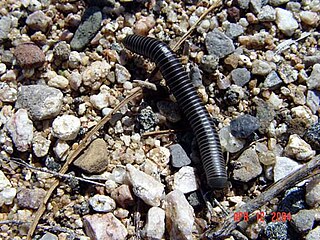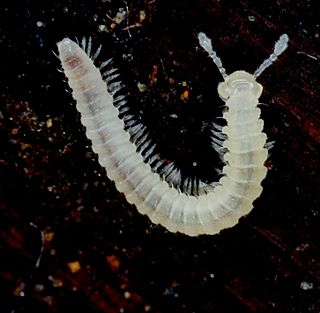
Polydesmida is the largest order of millipedes, containing approximately 3,500 species, including all the millipedes reported to produce hydrogen cyanide (HCN). Polydesmids grow and develop through a series of moults, adding segments until they reach a fixed number in the adult stage, which is usually the same for a given sex in a given species, at which point the moulting and the addition of segments and legs stop. This mode of development, known as teloanamorphosis, distinguishes this order from most other orders of millipedes, which usually continue to moult as adults, developing through either euanamorphosis or hemianamorphosis.

Xystodesmidae is a family of millipedes. Its members often have very small distributional areas, with many species only known from a single locality. They are found across the northern hemisphere, with peak diversity in the Appalachian Mountains, where one-third of the 300 or so species occur. They are particularly abundant in deciduous broadleaf forests in the Mediterranean Basin, Africa, Asia, Central and North America, and Russia. Information on basic taxonomy is scant for this family; for example, it is estimated that the genus Nannaria contains over 200 species, but only 25 were described as of 2006. By 2022, 78 species in Nannaria have been described.

Julida is an order of millipedes. Members are mostly small and cylindrical, typically ranging from 10–120 millimetres (0.39–4.72 in) in length. Eyes may be present or absent, and in mature males of many species, the first pair of legs is modified into hook-like structures. Additionally, both pairs of legs on the 7th body segment of males are modified into gonopods.

Harold Frederick Loomis was an American botanist and myriapodologist known for his contributions to agronomy, plant pathology, and millipede taxonomy. He worked for the U.S. Department of Agriculture for over four decades, studying diseases of crop plants, and was a colleague of Orator F. Cook. He also made major contributions to the natural history of Central America and the West Indies, naming over 500 species of millipedes in total. He co-described with Cook the leggiest animal on earth: Illacme plenipes, with over 700 legs.

Andrognathidae is a family of millipede in the order Platydesmida. There are about 17 genera and more than 30 described species in Andrognathidae.

Polyzoniidae is a family of millipedes in the order Polyzoniida. There are about 9 genera and at least 60 described species in Polyzoniidae.
Siphonotidae is a family of millipedes in the order Polyzoniida. There are about 15 genera and at least 40 described species in Siphonotidae.

Atopetholidae is a family of millipedes in the order Spirobolida. There are about 18 genera and at least 60 described species in Atopetholidae.
Allopocockiidae is a family of millipedes in the order Spirobolida. There are about five genera and eight described species in Allopocockiidae.

Cambalidae is a family of millipedes in the order Spirostreptida. There are at least 20 genera and 80 described species in Cambalidae.
Caseyidae is a family of millipedes in the order Chordeumatida. Adult millipedes in this family have 30 segments. There are about 7 genera and at least 40 described species in Caseyidae.

Cleidogonidae is a family of millipedes in the order Chordeumatida. Adult millipedes in this family have 28, 29, or 30 segments. This family includes the genus Tianella, notable for featuring adult millipedes with 29 segments, a number not found in the adults of any other chordeumatidan species. All Tianella species have adults with 29 segments except for two in which adults have only 28 segments. In the Tianella species with 29 segments, adult females have 48 pairs of legs, as one would expect in adult female chordeumatidans with one segment fewer than the 30 usually found in this order. There are seven genera and at least 140 described species in Cleidogonidae.

Conotylidae is a family of millipedes in the order Chordeumatida. Adult millipedes in this family have 30 segments. There are about 19 genera and at least 60 described species in Conotylidae.
Eurymerodesmidae is a family of flat-backed millipedes in the order Polydesmida. There are at least 2 genera and 30 described species in Eurymerodesmidae.
Macrosternodesmidae is a family of flat-backed millipedes in the order Polydesmida. There are about 9 genera and 16 described species in Macrosternodesmidae.
Crossosoma is a genus of millipedes in the family Craspedosomatidae. There are about 10 described species in Crossosoma.

Euryurus is a genus of flat-backed millipedes in the family Euryuridae. There are about 14 described species in Euryurus.
Desmonus is a genus of flat-backed millipedes in the family Sphaeriodesmidae. There are about 10 described species in Desmonus.

Sigmoria is a genus of flat-backed millipedes in the family Xystodesmidae. There are more than 40 described species in Sigmoria.
Rhachodesmidae is a family of flat-backed millipedes in the order Polydesmida. There are more than 20 genera and at least 80 described species in Rhachodesmidae.










